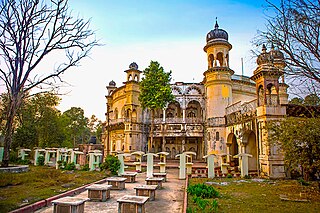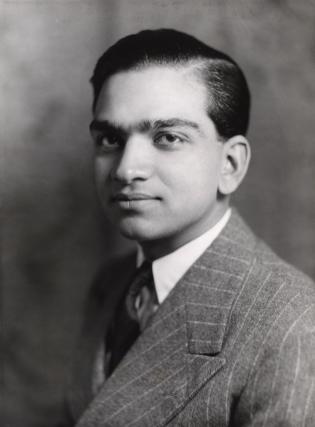Related Research Articles

The Central Provinces and Berar was a province of British India and later the Dominion of India which existed from 1903 to 1950. It was formed by the merger of the Central Provinces with the province of Berar, which was territory leased by the British from the Hyderabad State. Through an agreement signed on 5 November 1902, 6th Nizam Mahbub Ali Khan, Asaf Jah VI leased Berar permanently to the British for an annual payment of 25 lakhs rupees. Lord Curzon decided to merge Berar with the Central Provinces, and this was proclaimed on 17 September 1903.

Amethi is a city situated in the Indian state of Uttar Pradesh. Gauriganj is the administrative headquarters of the Amethi district. This district is a part of Ayodhya division in the Awadh region of the state. Amethi was 72nd district of Uttar Pradesh which came into existence on 1 July 2010 by merging three tehsils of the erstwhile Sultanpur district namely Amethi, Gauriganj and Musafirkhana and two tehsils of the erstwhile Raebareli district, namely, Salon and Tiloi. The town is part of the Amethi Lok Sabha constituency and Amethi Assembly constituency, which became reputed as a stronghold of the Indian National Congress party. The Congress leaders belonging to Nehru-Gandhi family won several elections from Amethi during 1980–2014. In 2019, Smriti Irani of Bhartiya Janta Party won this seat. Irani was defeated in 2024 by Kishori Lal Sharma of Indian National Congress.

Rewa is a city in the north-eastern part of Madhya Pradesh state in India. It is the administrative center of Rewa District and Rewa Division. The city lies about 420 kilometres (261 mi) northeast of the state capital Bhopal and 230 kilometres (143 mi) north of the city of Jabalpur. The maximum length of Rewa district is 125 km from east to west and the length of Rewa from north to south is 96 km. This area is surrounded by Kaimur hills to the south Vindhyachal ranges pass through the middle of the district.

Raman Singh is an Indian politician who formerly served chief minister of Chhattisgarh. He became the Chief Minister for three consecutive times and as a member of the Chhattisgarh Legislative Assembly representing Rajnandgaon since 2008 and from Dongargaon from 2004 to 2008. He also served as the 2nd and the longest serving Chief Minister of Chhattisgarh for 15 years from 2003 to 2018, Minister of State for Commerce and Industries in the Vajpayee cabinet from 1999 to 2003, Member of the Lok Sabha from Rajnanadgaon from 1999 to 2003 and a member of the Madhya Pradesh Legislative Assembly from Kawardha from 1990 to 1998.

The Eastern States Agency was an agency or grouping of princely states in eastern India, during the latter years of the British Raj. It was created in 1933, by the unification of the former Chhattisgarh States Agency and the Orissa States Agency; the agencies remained intact within the grouping. In 1936, the Bengal States Agency was added.

Major General Maharaja Sawai Governor Sir Man Singh II GCSI GCIE was an Indian prince, government official, diplomat and sportsman.

Rewa State, also known as Rewah, was a kingdom and later princely state of India, surrounding its eponymous capital, the town of Rewa.

The Daly College is a group of institutions consisting of a co-educational private boarding, day school, a private junior school, an undergraduate management school and a postgraduate business school, located in Indore, Madhya Pradesh, India. It was founded by Sir Henry Daly of the British Indian Army during India's colonial British Raj, following an English public school model. The school started in 1870 as the Residency School. It was then renamed as the East Rajkumar College in 1876, and in 1882, it came to be known as The Daly College. It was established by the Resident Governor of the erstwhile Presidency, to educate the children of the royalty, nobility and aristocracy of Central Indian Princely States of the 'Marathas', 'Rajputs', 'Mohameddans' and 'Bundelas'. It is one of the oldest co-educational boarding schools in the world.
The Darbhanga Raj, also known as Raj Darbhanga and the Khandwala dynasty, was a Maithil Brahmin dynasty and the rulers of territories, not all contiguous, that were part of the Mithila region, now divided between India and Nepal.
Raja Nareshchandra Singh, was an Indian ruler of Sarangarh state in Raigarh District, Chhattisgarh. He also served as Chief Minister of undivided Madhya Pradesh.

Brigadier HH Shri Maharajadhiraj Maharaja Mahim Mahendra Maharao Raja Sir Bhim Singh II Bahadur, KCSI was the last ruling Maharaja of the Hada Chauhan dynasty of the Princely State of Kotah from the year 1940 to 1947.
Maharaja Kamakhya Narain Singh Bahadur of Ramgarh, Jharkhand was the Maharaja Bahadur of Ramgarh Raj and later a politician. He belonged to the Rathore clan of Rajput.

Rajendra Narayan Singh Deo KCIE was an Indian politician and the last ruler of the princely state of Patna in Odisha before Indian independence in 1947. He was the President of the Ganatantra Parishad political party from 1950 to 1962 and the President of the Odisha state unit of the Swatantra Party after its merger with the Ganatantra Parishad in 1962. Deo was the Chief Minister of Orissa from 1967 to 1971.

Kawardha State was one of the princely states in the Central Provinces of India during the period of the British Raj. The capital of the state was Khairagarh town, in Kabirdham district of Chhattisgarh state. The Bhoramdeo Temple is located less than 20 km to the west of the main town.
Vishwaraj Pratap Singh was prince and later held the officially, the titular Raja of Kawardha State from 1959-1971. He was eldest son of Raja Dharamraj Singh. He was a member of Legislative Assembly of Madhya Pradesh from Kawardha constituency as a member of Akhil Bharatiya Ram Rajya Parishad from 1962-67.
Yogeshwar Raj Singh is a scion of Kawardha Raj family and son of late Vishwaraj Pratap Singh.
Thakur Pyarelal Singh, was an Indian freedom fighter against British rule and the founder of labour movements in Chhattisgarh. He led three workers' movements in Rajnandgaon Riyast in 1919-1920, 1924 and 1937. He was also conferred with the honorary title of "Tyagmurti", which means "epitome of sacrifice".

HH Saramad-e-Raja-e-Hindustan Raj-Rajeshwar Raj-Rajendra Maharajadhiraj Shri Maharaja Sawai Sir Madho Singh II, was the Maharaja of the Princely State of Jaipur from the year 1880 until 1922. He was the adopted son of the previous ruler Sawai Ram Singh II, Maharaja of Jaipur.
References
- ↑ Memoranda on the Indian States. Manager of Publications. 1939. p. 114.
- ↑ Who's who in India, Burma & Ceylon 1940- Page 83
- ↑ The Times of India Directory and Year Book Including Who's who by Sir Stanley Reed Bennett, Coleman & Company, 1938 pp:1184
- ↑ Memoranda on the Indian States -1939- Page 114
- ↑ "Raipur Places to Visit | Attractions in Raipur India". Archived from the original on 9 October 2014. Retrieved 23 August 2022.
- 1 2 "Kawardha". Archived from the original on 31 August 2018. Retrieved 23 August 2022.
- ↑ S. Gajrani (1 September 2004). History, Religion and Culture of India. Gyan Publishing House. p. 27. ISBN 978-81-8205-064-8 . Retrieved 29 September 2012.
- ↑ India. Bureau of Public Information (1939). Indian information series. p. 331. Retrieved 29 September 2012.
- ↑ "General Elections of MP 1957" (PDF). Election Commission Of India. 2004. p. 7.
- ↑ India Votes. 1968. p. 294. Retrieved 29 September 2012.